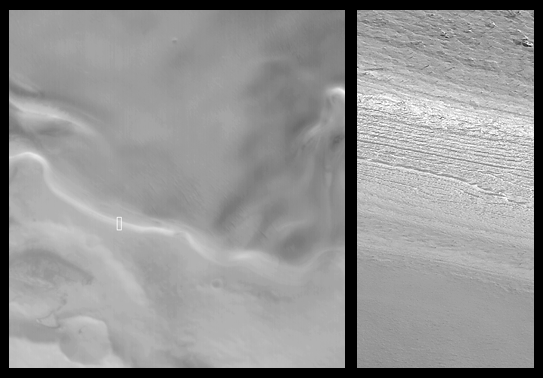
On December 3, 1999, the Mars Polar Lander will touch down on the upper surface of a thick accumulation of layered material known as the "South Polar Layered Deposits." The Mars Global Surveyor (MGS) Mars Orbiter Camera (MOC) has been providing stunning new pictures of the south polar layered deposits that, in conjunction with Mars Polar Lander observations, will eventually help answer many questions about this terrain.
Both the north and south polar regions are blanketed by thick accumulations of layered material. This has been known since the 1971-1972 mission of Mariner 9. Based upon data from the Mariner and Viking projects in the 1970s, the polar layered deposits have long been considered to be accumulations of dust and ice. The layering is thought to indicate changes in how ice and dust accumulate at the poles over the course of millenia. Changes in climate might affect the thickness and composition of polar layers in a way that is analogous to how years of drought and years of plentiful rain change the width of rings in a tree trunk on Earth.
The pictures shown here provide new details of what the south polar layered deposits look like at extremely high resolution from the MGS MOC. The picture on the left is a context frame taken at the same time as the high resolution view on the right. The context image covers an area about 115 km (71 mi) across and shows a thick, smooth blanket of material covering the upper 2/3 of the frame. This thick blanket is the south polar layered deposit material. The circular features at the lower left in the context image are craters occurring outside the polar layered deposit. More craters occur underneath the polar layered deposits. The small white box indicates the location of the MOC high resolution image (right) along the edge of the polar layered deposits. The picture is illuminated from the lower right.
The picture on the right shows one of the clearest and highest-resolution images of south polar layered material ever obtained. Located at 73.0°S, 224.5°W, this picture covers an area approximately 550 km (340 miles) northwest of where the Mars Polar Lander will touch down in December. Illuminated from the lower right, this scene covers an area 1.5 km (0.9 mi) wide and 4.6 km (1.9 mi) long. The smallest objects that can be seen are about the sizes of automobiles. Small dark streaks in the upper right are formed from winds that have blown small patches of sediment across the surface of the layered material. Layers of only a few meters thickness are exposed along the edge of the polar layered deposits. The amount of dust versus ice in these layers is unknown. It is hoped that the Mars Polar Lander will be able to help determine--at least for the upper layers of the deposit--how much ice is present.

